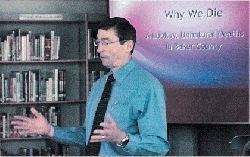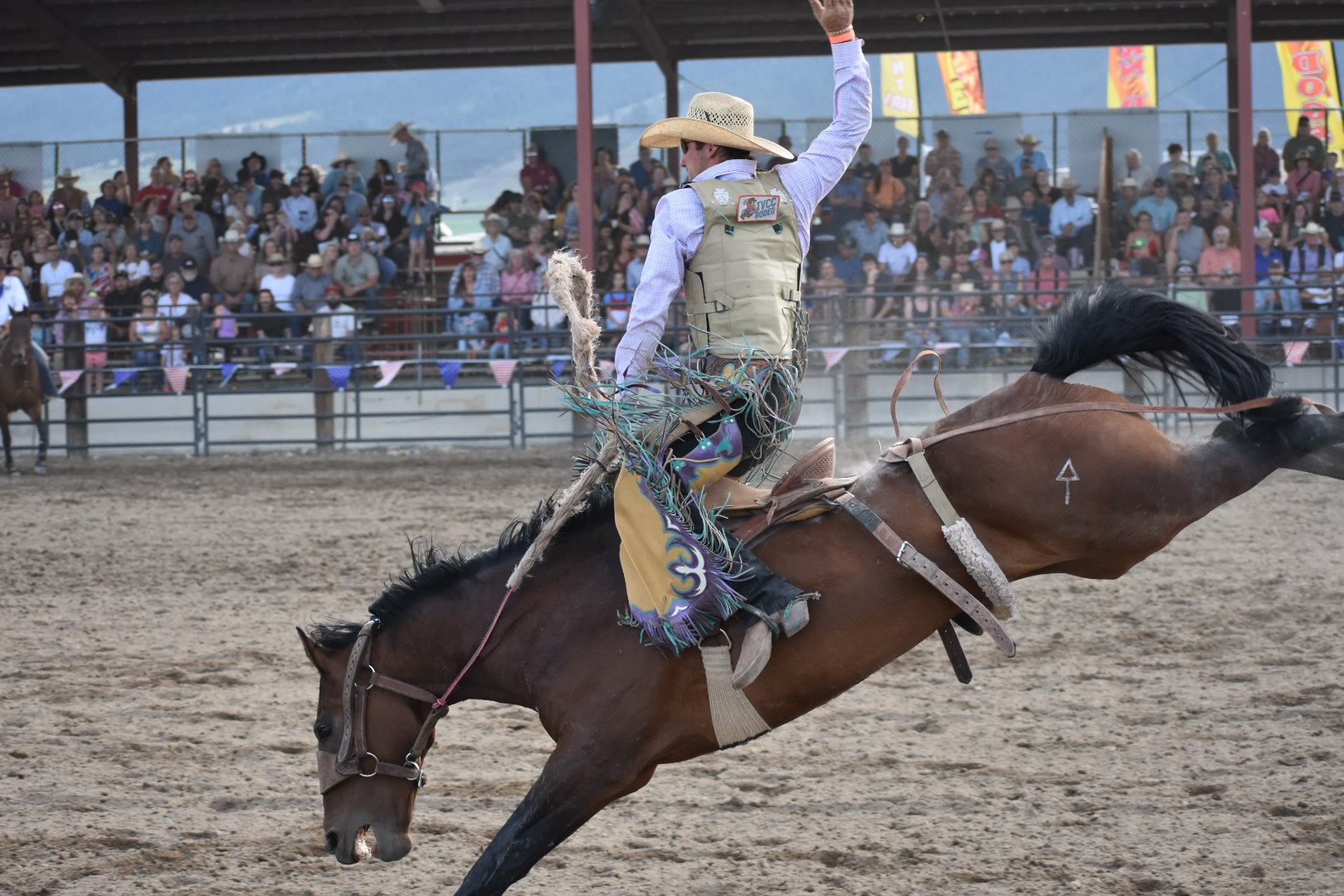The ways people die in Baker County
Published 12:00 am Thursday, June 5, 2008

- Dr. James Davis, who's been medical examiner in Baker County for 12 years, shared his experience and knowledge with students at Baker High School on Wednesday. (Baker City Herald/S. John Collins).
By MIKE FERGUSON
Baker City Herald
Dr. James Davis has a Top 10 list that’s not at all funny.
Davis, suffice it to say, is not David Letterman.
Davis’ list details the Top 10 ways, excluding natural causes, that people have died in Baker County over the past six years, a list on which only Davis can speak with any authority.
Davis, an ophthalmologist, is Baker County’s medical examiner. He investigates each unnatural death that occurs in the county.
He shared his experiences and his list with health and sociology students at Baker High School Wednesday.
Davis offered to share his data with the students.
Of the 193 deaths Davis noted between 2002 and 2007, 111 were from natural causes. Of the remaining 82 deaths, 63 were ruled accidental, 17 suicide and two were homicides.
Here’s Davis’ list of the Top 10 Causes of Unnatural Deaths in Baker County, with selected comments he made to the 30 or so students who attended the class in the BHS library.
10: Sudden Infant Death Syndrome
(1 case)
A baby’s airway becomes obstructed because of a spasm in its larynx. Perhaps the problem is exacerbated because the baby has a cold, Davis said.
andquot;It’s a babysitter’s worst nightmare, but don’t stop babysitting because of it,andquot; he told students. andquot;It’s extremely rare,andquot; accounting for only about one death in 10,000.
9: Homicides (2 cases)
andquot;That’s the good news, that there’s not too much violent crime in Baker County,andquot; he said.
Davis said he first became a medical examiner 12 years ago after reading an article that advised readers, andquot;If you want to get away with murder, do it in Baker County, because no one will catch you.andquot;
It’s not true, in his experience.
andquot;The police departments here are extremely good at investigating things,andquot; he said.
He said he got interested in the work serving as a Navy flight surgeon. His work then involved investigating aircraft accidents.
andquot;Finding out why people were drilling holes in the ground,andquot; he said, andquot;prevented a lot of other accidents.andquot;
8: Falls (3 cases)
Most deaths associated with falls aren’t investigated, he said, because the person who’s had the fall generally an elderly person has been in the hospital andquot;for a long timeandquot; leading up to his or her death.
andquot;These old people are not anything like the rest of us,andquot; Davis told the students. andquot;They are extremely fragile. You could trip and fall and nothing would happen, but they are unsteady on their feet. They could trip on a rug or the curb just about anything.
andquot;If you’re aware of that, you can help them. Offer them your arm and walk them places. You can’t imagine what a hit that will make you with older people if you do that. You would be given a badge for being a superhero in my mind.andquot;
7: Co-sleeping (3 cases)
Having a baby sleep with its parents andquot;is a bad thing for very young infants,andquot; Davis said, because andquot;it’s extremely difficult for an infant to raise its head off the surface of the bed,andquot; and its head can become wedged between the mattress and bedframe.
6: Drowning (3 cases)
andquot;Nobody dies from drowning because they don’t know how to swim,andquot; Davis said. andquot;They drown because the person was incapacitated by something else,andquot; such as being struck on the head when a boat capsizes. Alcohol can be a contributing factor, as can hypothermia.
5: Asphyxia (4 cases)
Of these cases, two died in fires.
4: Seizure (4 cases)
Davis said he was surprised that even one person died of a seizure during his study period. Even during a grand mal seizure, episodes generally last two minutes or less, he said.
The person’s airway can be obstructed by his or her tongue, or there can be a series of protracted seizures leading to death.
Students who are presented with someone having a seizure should andquot;see that their airway is clear, call 911 and you can be a hero,andquot; Davis said.
3: Drug and alcohol overdose (16 cases)
These are not cases of drunk drivers killing people, Davis said, but cases andquot;that are a direct result of the drug.andquot; Many deaths are due to people misusing their prescription pain medication, he said.
andquot;They take more than the prescribed amount and they feel a lot better, so they figure, ‘if it feels that good, I will take more,’ andquot; Davis said. andquot;By that time they don’t remember how many they’ve taken and they take a lethal amount.andquot;
Oftentimes, family members are aware of the problem and they ration the medication themselves, Davis said.
Davis then took students through this scenario: a friend has had too much to drink at an impromptu party andquot;with lots of alcohol and no adults. What do you do?andquot;
The correct answer is to call the paramedics, he said, and risk your parents finding out where you’ve been and what you’ve done.
andquot;Call 911 anytime someone is unconscious,andquot; he said. andquot;They deserve immediate medical attention.andquot;
2: Suicide (17 cases)
Fifteen of these deaths were from gunshot wounds, Davis said, while one was a drowning and one a drug overdose.
Some people who killed themselves were sick with cancer and andquot;didn’t want to put their families through a long, drawn-out death,andquot; Davis said. Others had problems with the law.
Davis checked blood-alcohol levels on each person. About 90 percent were intoxicated at the time of their death.
andquot;That makes sense,andquot; he said. andquot;I would think, ‘killing myself will hurt. I need something to take the edge off my anxiety’. You wouldn’t do this (commit suicide) unless your judgment was impaired.andquot;
Davis said that in every case, each person who took their own life andquot;could have worked through their problems, with help.andquot;
1: Motor Vehicle Accidents (29 cases)
27 of the 29 cases were single-vehicle accidents. Driving on icy freeways presented the greatest risk, followed in order by falling asleep, driving while intoxicated and rolling an all-terrain vehicle.
Most accidents involving slipping or rolling on the ice occurred not when one might expect them to, Davis noted: they happened as dusk is descending, when there’s no apparent ice on the roadway, when it’s been raining and as temperatures were falling from about 40 degrees into the freezing range.
Almost all the fatal accidents he investigated occurred between Mileposts 290 and 280 near North Powder, where temperatures often are about five degrees colder than they are in Baker City.
Davis said two of his own children andquot;contactedandquot; deer while driving. One accident totaled a vehicle. The family determined it’s a safer policy to hit the deer rather than swerve and perhaps cause the car to slide or roll on an icy roadway.
andquot;Don’t be determined to save the deer’s life,andquot; he advised students. andquot;That deer will have to give its life to save others.andquot;









